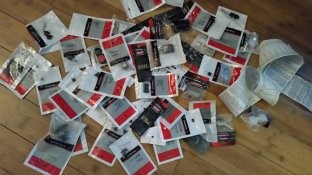joshgladstone
Member
Hey everyone, I wasn't sure if I should post this in here or the Exposure forum, but this seems more like the DIY type place.
So when I'm out taking photos and I need a meter, I usually walk around with an old GE PR-1, because it's a nice size and shape, and it works great. But it definitely has its limitations, especially with lower light levels. I've also got a Spectra IV for cine metering, but that's overkill to carry around in my pocket. I've also been getting into Arduinos a bit lately, and had purchased a cheap Pro Mini clone for a different project I had in mind. When I started playing with it, I began to wonder if I could make a small DIY light meter. I looked into the parts and it turned out the whole thing would be really inexpensive. So I gave it a shot!
It's called LUX (for now), and it has a range of ISO settings from 1-6400, and shutter speeds from 1/3000 sec to 60 minutes, and cine speeds from 1-300fps (and of course I could always add more). It's still missing a couple of features that I want to add, and it needs to be assembled into a case, but it's close to done! Here's a video:
[video=youtube;2EB30AjOrN8]https://www.youtube.com/watch?v=2EB30AjOrN8[/video]
Comments and questions welcomed. Thanks!
Parts list:
Arudino Pro Mini clone (http://www.amazon.com/Estone-Version-Atmega328-Arduino-Compatible/)
Adafruit TSL2561 Light Sensor (http://www.adafruit.com/products/439)
64x128 OLED Display (http://www.amazon.com/gp/product/B00O2LLT30/ref=oh_aui_detailpage_o00_s00)
Rotary encoder with push button (http://www.amazon.com/gp/product/B00KHTLY7M)
So when I'm out taking photos and I need a meter, I usually walk around with an old GE PR-1, because it's a nice size and shape, and it works great. But it definitely has its limitations, especially with lower light levels. I've also got a Spectra IV for cine metering, but that's overkill to carry around in my pocket. I've also been getting into Arduinos a bit lately, and had purchased a cheap Pro Mini clone for a different project I had in mind. When I started playing with it, I began to wonder if I could make a small DIY light meter. I looked into the parts and it turned out the whole thing would be really inexpensive. So I gave it a shot!
It's called LUX (for now), and it has a range of ISO settings from 1-6400, and shutter speeds from 1/3000 sec to 60 minutes, and cine speeds from 1-300fps (and of course I could always add more). It's still missing a couple of features that I want to add, and it needs to be assembled into a case, but it's close to done! Here's a video:
[video=youtube;2EB30AjOrN8]https://www.youtube.com/watch?v=2EB30AjOrN8[/video]
Comments and questions welcomed. Thanks!
Parts list:
Arudino Pro Mini clone (http://www.amazon.com/Estone-Version-Atmega328-Arduino-Compatible/)
Adafruit TSL2561 Light Sensor (http://www.adafruit.com/products/439)
64x128 OLED Display (http://www.amazon.com/gp/product/B00O2LLT30/ref=oh_aui_detailpage_o00_s00)
Rotary encoder with push button (http://www.amazon.com/gp/product/B00KHTLY7M)





